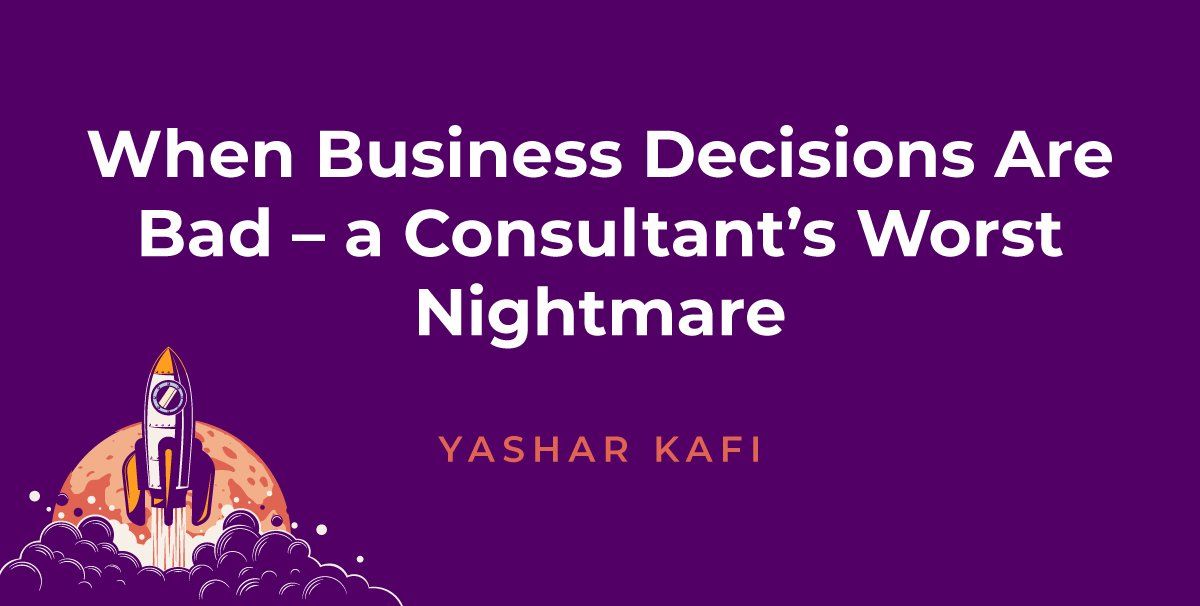When Business Decisions Are Bad – a Consultant’s Worst Nightmare
No consultant wants to inherit bad business decisions. Furthermore, no business wants to have to hire a consultant to come in and save the day due to bad business decisions. But at the end of the day, everyone makes bad business decisions.
But when decisions are bad, how a business recovers is the most important. For business leaders recovering from bad and costly business mistakes, we unpack why this happens and share some steps you can take to mitigate the fallout.
What Causes Bad Business Decisions?
While no business is expected to never make a misstep along the way to success, there are common pitfalls in decision-making processes. Let’s look at some of the most dangerous ones, so you can avoid them and up your decision-making game overall.
- Making assumptions/operating according to biases: You know what they say about assuming… This misstep can happen when making a judgment call based on a previous experience or situation you have dealt with. This can lead to complications, as you can’t know all the facts about this new situation. When you compare it to an earlier one, you aren’t opening yourself up to find the best course of action for this case. It’s an opportunity wasted at best and, at worst, a mess you’ll have to clean up.
- Choice paralysis: This can happen when a business leader doesn’t want to act on any set course of action. The big problem with this course of action (or lack thereof) is that problems don’t disappear on their own. They often get worse until they are dealt with head-on.
- Not delegating: We have all had one of these leaders in our lifetime—the one who has to have their hands on everything. They are the corporate world’s micro-managers, leaving chaos and frustration in their wake due to this desire for control. While they may meet goals with this approach, it also limits you (lack of collective creativity and innovation due to only one perspective). It opens you up to risks of failure due to your assumptions and bias as a micro-manager.
- Getting bogged down by unimportant information: Many leaders fall into this trap because they hesitate to make decisions without feeling like they know all the details. There is logic to wanting to know your facts, but the mistake lies in waiting around too long for some neon sign of clarity to appear. Once you have the information necessary to make an informed decision, you must make moves. Otherwise, you can succumb to that dreaded choice paralysis.
When Business Decisions Are Bad – How to Bounce Back:
So, the inevitable hiccup happens. Someone makes a bad decision. But rather than waste time beating yourself up or wallowing as you sit and wait for the ramifications, dust yourself off (immediately) and get proactive with a rapid response.
So, now what? I suggest taking a course of action cue from the well-known OODA loop. An acronym standing for Observe, Orient, Decide, Act, this is a four-step approach to decision-making designed by military strategist and U.S. Air Force Colonel John Boyd, who applied it to the combat operations process.
The OODA loop focuses on these four steps to see a situation, place it in context based on the information available, then use context to make an informed decision to act. Its genius lies in its fluidity for adaptation, where you constantly repeat this process as dynamics shift and situations arise. It’s a living decision-making model, so for our purposes, you can use this the minute someone makes a bad decision to course-correct quickly and concisely.
Putting Plan B into Practice
The OODA loop model will require you to shift and swivel from Plan A (when you hit a snag) to putting Plan B into practice, which will require you to assess what your new options are now (post snag).
As you navigate the aftermath of bad decisions, follow the clues—they will show you where you need to course-correct and which direction to take next. Often, this will lead to reversing course entirely and making amends when necessary. And in more extreme cases, it can lead to the necessity to cut ties based on the information brought forth by the said snafu.
If All Else Fails, Call a Consultant
So you have worked the OODA loop but have gotten to the point where you feel like you’re only going in circles, not making any real progress or finding sustainable solutions. This is never a fun place to be. It can be annoying, frustrating, and even terrifying. The good news is that calling a consultant can help when all else fails. Don’t be shy—or too proud—to make that call; we all need a little help sometimes.
Are you looking for help? Connect with us today to find out how we can serve you and your unique situation.




